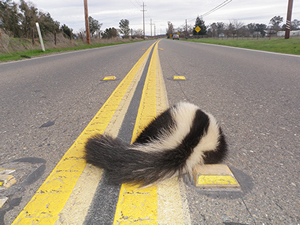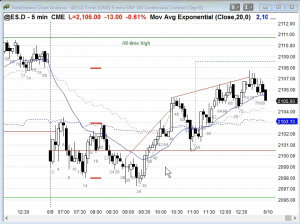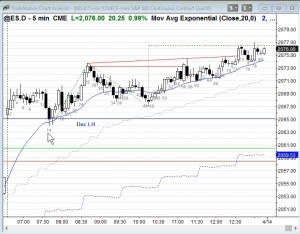Skunk stops—taking the middle road
BPA trading room Q&A: April 13 & June 9, 2016
Question 1: I sold the 14 close, okay, and scaled in, closed out above 13. [That makes perfect sense. I think that’s reasonable.] I bought the 26 close and scaled in, closed out below 24. [Okay.] Can you comment on these decisions? Is this representative of how many tradings tend to play out? Really trying to follow along.
Video duration: 6min 14sec
You can also view this video on Al’s YouTube Channel if needed.
Skunk stop trading
 Yeah, I think what you’re doing is, you’re using skunk stops. Stops that stink or dead skunk stops, right? This comes up all the time. So I think selling the 14 close, you’re taking a chance that you’re going to get the breakout below the moving average and that you get follow through selling below 1. I think that is okay. I think most traders who did that would exit above 13. So I think selling the 14 close, getting out above 13 is reasonable. Other traders will say, “Nah, it’s a trap; it’s a trading range. It will go above 13 and stay below the 5 high,” and 5 high is not much above the 13 high, so if you’re going to sell 14 close, put your stop above 5. And I don’t have a problem with that either. You know, you just never know in hindsight.
Yeah, I think what you’re doing is, you’re using skunk stops. Stops that stink or dead skunk stops, right? This comes up all the time. So I think selling the 14 close, you’re taking a chance that you’re going to get the breakout below the moving average and that you get follow through selling below 1. I think that is okay. I think most traders who did that would exit above 13. So I think selling the 14 close, getting out above 13 is reasonable. Other traders will say, “Nah, it’s a trap; it’s a trading range. It will go above 13 and stay below the 5 high,” and 5 high is not much above the 13 high, so if you’re going to sell 14 close, put your stop above 5. And I don’t have a problem with that either. You know, you just never know in hindsight.
Choose your stop
If I sold the 14 close, I would be concerned about 15 and 16. And I probably would get out above 16, and that’s why 17 looks that way. A lot of the bears did that; they were not happy with 15, not happy with 16, and they decided if it was up one more bar, “I’m out of here.” So a lot of the bears exited above that.
As far as buying the 26 close, I talk about that at the time. I said, “If you’re buying up here, you really need a wide stop because this has the potential to be followed by a deep pullback and a trading range.” So if you’re buying above 26, either you get out below 27 or on the 29 close, the early exits. Or you have to use a really wide stop, like below 14. And that 24 was a magnet at the bottom of the most recent buy climax — 24, 25, 26 — and if we start going down, it’s probably going to go below the 24 close. So that’s the one place where you do not want to put your stop. Either you get out before then or you use a stop at the bottom of the bull leg, 14.
Focusing on risk only
So that’s my thought there. I understand when traders start out they only think one thing: Risk. “I don’t want to lose — I cannot lose much money,” and therefore, beginners tend to use tight stops. But they also are kind of torn. “Okay, Al keeps saying swing. I got to use a swing stop, but I want to use the smallest possible swing stop so that I’m not risking too much.” And the result is they end up using a skunk-type stop. An in-between stop. They don’t want to take the early exit, below 27. They want to give their trade time, but they don’t want to really risk all the way down here [below 14] because it’s just too much. And they end up getting out somewhere in the middle, which is around a 50 percent pullback. And that’s where strong bulls are starting to buy. And I said at the time, “Strong bulls will buy the 24 low and bears will take profits at the 24 low, so we’ll probably get at least a little bit of a bounce.”
Out early or wide stop
I hope that’s clear. So you either have to decide that “I’m going to get out early and then if it keeps going up, I’ll buy again.” Or “I’m going to use that swing stop — which is really far away and I don’t want to use it, but that’s my choice. I’m either going to trade small enough so that I can use the swing stop and scale in lower. Or I’m going to get out early, like below 27 or on the 29 close.” And anything in between those two choices is, I think, a losing strategy.
Question 2: I bought the close of 46 [that’s okay] stop below 45. [Okay.] I scaled in once more and I got stopped out on my stop loss. Should I have exited earlier? [Okay.]
Another day, another skunk stop
 Every now and then, I talk about a skunk exit, and that’s an example of a skunk exit, okay? You have a buy climax, okay, and there are going to be a whole bunch of stops below 46, below 45, right? So you know that if it starts going down, it’s going to get at least a tick below 46. However, you also know that there’ll be buyers down there as well. And then because we might be getting a test at the open of the day, there probably will be buyers at the open of the day. I bought at the open of the day. I bought a couple ticks above the open of the day for a scalp.
Every now and then, I talk about a skunk exit, and that’s an example of a skunk exit, okay? You have a buy climax, okay, and there are going to be a whole bunch of stops below 46, below 45, right? So you know that if it starts going down, it’s going to get at least a tick below 46. However, you also know that there’ll be buyers down there as well. And then because we might be getting a test at the open of the day, there probably will be buyers at the open of the day. I bought at the open of the day. I bought a couple ticks above the open of the day for a scalp.
Middle of two good choices
So when I say a “skunk exit,” I’m talking about one in the middle of two good choices, and usually you get killed if you’re in the middle. So to me, the choices are — you can see what happened: 46 close; bulls did not like 47, they hated 48, and then look what happened 49, right? It went back above the 46 close and came back down. So that tells you that a lot of the Buy the Close bulls’ 46 were disappointed 48 and they got out on 49. And more and more bulls started to get out here. So to me, I’m either getting out below 48 or I’m getting out below 50 or 49, or I’m going to use a really wide stop down here [below 33].
And what bulls do is they either get out here [B48] or they get out down here [below 33], and as it’s selling off they can be buying one, two, three points down. A lot of bulls don’t do that. Instead, they wait for a bull bar — 54 — and then they buy above the bull bar. And then they try to get out breakeven around their original entry. That’s what caused this big tail here [B60]. Or they just hold part or all to see if we get a swing up.
Understand what is going on
So back to your question, you buy that close [46] stop down here [below 45]. That’s the one place I would not put my stop. I would either get out below 48 or below 49, below 50. Or I would just use a wide stop down here [below 33] and wait for a bull bar and buy more above the bull bar. Hard to do, especially when you see a collapse like 53. But if you understand what’s going on, then it’s simply a test of the open in a trading range day, it’s easier to rely on the wide stop, okay?
Al Brooks
Information on Al’s Online day trading room



Excellent discussion about skunk stops. Boy, have I felt that pain!
Slightly different question about stops.
I trade EUR/USD, which has a lot of flat periods. More than once I’ve entered trades looking for a swing, using an appropriate stop and swing target.
Things go ok for a while, with the target still a ways away. Then the market enters a flat period, sometimes for hours. It crosses my mind that the original reason for entering the trade appears to be long gone.
At this point I often move the stop to breakeven or a small positive/negative. I reason that the original reasons for entering the trade are no longer valid after 20 – 50 bars of flatness, and that to stay in the trade for a swing is whimsical.
I can tough it out without anguish using the original stop and target (which follows my rules and is sound from a trader’s equation standpoint), but which approach makes more sense?
My general rule is to exit any trade that is not unfolding the way that I think it should. It it resumes strongly, I can always enter again. If it resumes and is weak, I just wait for another setup.
Excellent video! This is key for me; not getting caught in the middle. Thanks to Al and Richard!
Hi Al,
In your books and videos, you never talked about “selling OTM Calls”, “selling OTM Puts”, “Covered Calls”
I am working on videos about options, but I have to complete the course 1st. The books and videos have been about trading the underlying, not derivatives like options.
As a short answer, selling OTM puts makes sense if a trader is eager to buy a stock, but would like to buy it for less.
Selling OTM calls only makes sense if a person is long the stock. If he does it right, he can add about 10% to his annual return selling covered calls.
Selling naked call spreads has a high probability of success. Whenever there is a high probability, the risk/reward is bad. I rarely do it because there is the constant worry that, if the market goes above your short, you will find the underlying in your account in the morning. This adds steps, which I always try to minimize, especially in a low reward trade.